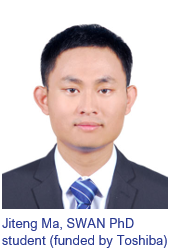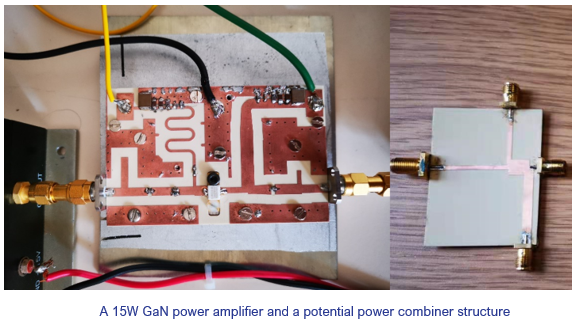In the last blog in our ‘spotlight’ series, we spoke to Dr Gavin Watkins, Programme Leader at Toshiba Europe Limited, about his work co-supervising one of SWAN’s PhD students, Jiteng Ma. In speaking to Gavin, we explored how this kind of collaboration between academia and industry contributes to the process of knowledge exchange within the SWAN project.
 This time, we sat down with Jiteng to ask him a few questions about his work and to take a deeper dive into the research he has been doing with Gavin in developing novel designs for digital power amplifiers (DPAs).
This time, we sat down with Jiteng to ask him a few questions about his work and to take a deeper dive into the research he has been doing with Gavin in developing novel designs for digital power amplifiers (DPAs).
What is the key focus of your PhD and how does this relate to SWAN?
My main focus is on the design of radio frequency (RF) transmitters. We propose a novel multi-way digital power amplifier (DPA) architecture to improve the efficiency and the linearity of amplifying the orthogonal frequency-division multiplexing (OFDM) modulated signal. Due to its agile nature, this technique can be used for different modulated signals and can meet various design requirements. It has the potential to become a strong candidate for the SWAN system.
Can you give us a brief overview of the work you have been doing recently?
Based on the statistical distribution of the high peak-to-average power ratio (PAPR) OFDM signal and the quantisation theory, we propose an approach to improve the DPA linearity. A prototype DPA circuit has been designed and is being fabricated.
We have developed a fully OFDM simulation system to verify the feasibility and the performance of this designed DPA circuit. We conclude that this proposed DPA reaches very high system efficiency for OFDM modulated signal without degrading much linearity.
What will be the key outputs of this particular piece of work?
A prototype DPA circuit will be developed to verify the theory. The DPA theory and measurement result will be summarized in a high-quality journal paper. We hope that this design process can be patented.
What are the next steps for this section of your research?
Joint optimisation will be carried out to improve both linearity and efficiency of DPA. We will then fabricate the DPA system and measure its performance.
Further work will be done to explore a rapid passive microwave structure designing approach. There are many possible topologies for a human being to manually evaluate, or even conceive of in the first place. We are investigating the deep learning method to speed up the power combiner designing process. In the next steps, more neural network structures will be tested, including convolutional neural network (CNN), recurrent neural network (RNN), and AutoML. A self-designed neural network might be an optimal choice.
Can you tell us of one recent publication in the world of communications systems and networks research that has interested you?
The following two papers had a positive influence on me. The first paper presents a similar power mixer architecture. We have implemented additional techniques to improve the performance. The second paper introduces machine learning to design the RF filter, which inspired me to design microwave power combiners using a machine learning approach.
[1] Kousai S, Hajimiri A. ‘An octave-range, watt-level, fully-integrated CMOS switching power mixer array for linearization and back-off-efficiency improvement’ [J]. IEEE Journal of Solid-State Circuits, 2009, 44(12): 3376-3392.
[2] Jin J, Zhang C, Feng F, et al. ‘Deep neural network technique for high-dimensional microwave modeling and applications to parameter extraction of microwave filters’ [J]. IEEE Transactions on Microwave Theory and Techniques, 2019, 67(10): 4140-4155.
Is there anything else you would like to tell us?
I always appreciate discussing techniques for future agile transmission architectures and hardware designs using machine learning. Going forward, I hope to continue to be able to cooperate with talented researchers and develop useful technologies that people can benefit from in real life.
SWAN Prosperity Partnership
SWAN is an EPSRC Prosperity Partnership project dedicated to the creation of Secure Wireless Agile Networks (SWAN) that are resilient to both cyber attacks and accidental or induced failures. The partnership is made up of contributors from the Smart Internet Lab at the University of Bristol, Toshiba Research Europe Ltd, GCHQ, and Roke Manor Research Ltd.
Interested in reading more about SWAN and our programme of research? Take a look at our website for more information or sign up to our newsletter for regular updates on SWAN activities and opportunities to get involved.

